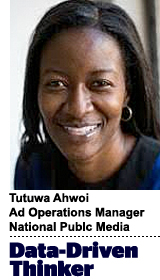 “Data-Driven Thinking” is written by members of the media community and contains fresh ideas on the digital revolution in media.
“Data-Driven Thinking” is written by members of the media community and contains fresh ideas on the digital revolution in media.
Today’s column is written by Tutuwa Ahwoi, ad operations manager at National Public Media.
The podcast industry faces a glut of obstacles: fragmentation in listening, a lack of discovery and insufficient measurement, to name a few.
It’s reassuring that there are significant moves being made to address some of the issues that are hindering even stronger growth within the podcast industry.
The more promising approaches I see aimed at resolving these obstacles include better marketing, content and measurement, with a healthy dose of competition.
Better measurement capabilities
Accurate audience and listening data and measurement remains a significant hurdle that needs to be overcome for the podcast industry to advance, especially in terms of revenue. What’s at stake is millions of dollars’ worth of revenue from potential advertisers who want to be assured of a significant return on investment from their media spending.
Many other forms of advertising – radio, print, online display and television – can provide accredited measurement that guarantees audience types and numbers. Advertisers, especially brand advertisers focused on establishing connections and close, long-term relationships with consumers, want assurance that their ads are being listened to, acted upon and making an impression on listeners.
Until there are easy and convenient ways of measuring and attributing any lift in audience impressions to podcasts, advertisers will hesitate to spend at the scale seen in other consumer mediums of information and entertainment.
Consequently, I believe that the podcast industry is highly aware of this scenario and taking strong steps toward solving for this challenge. Otherwise, a lack of momentum in addressing the measurability conundrum would quickly flatten, stall or even reverse the progress made by the podcasting industry in the past several years.
In 2017, the IAB updated its Podcast Measurement Technical Guidelines to provide standards for measuring podcast ads and audience. The guidelines aren’t perfect, but they introduce reliable and accepted standards around measurement.
Until guidelines’ release, few agreed on the definition of a download, for instance, so publishers didn’t report numbers in the same way. An independent, third-party source of verification is critical for advertisers deciding where to allocate marketing budgets.
The new guidelines focus on server-side data, but the intention is to eventually include client-side data. With server-side measurement, every time an audio player requests a podcast from a server, it is logged and metrics for downloads are generated. However, server-side metrics cannot determine whether the podcast was actually listened to. That information comes from client-side systems or podcatchers, such as Apple’s Podcasts or iTunes, or third-party players such as Stitcher.
With half of listening performed via iOS devices, Apple is the dominant client-side platform. But, it can only provide data on listening within its own environment. Apple has historically been slow to provide listening data to publishers.
Due to the fragmentation in listening, all the other third-party podcast apps and players would have to adopt similar measurement standards for client-side measurement to become accepted. Furthermore, client-side data has been challenging to acquire, and it was only last year that Apple released its Podcast Analytics tool, providing more insight for advertisers and publishers via an anonymous aggregation of listening data on a per-episode basis.
Having standardized industry measurement metrics and access to listening data provides podcast publishers with credibility to assure marketers that their campaign goals can be achieved. Measurement standardization is critical to move the revenue needle for publishers, fine-tune podcast content and attract more listeners.
More competition
Although there are several choices for listening to podcasts, Apple Podcasts has become the primary mechanism for consumption. There are also myriad third-party podcast players available, including third-party players such as Stitcher Radio, Overcast FM, Pocket Casts and TuneIn Radio.
More than 50% (PDF) of listening is done through the Apple iOS Podcast App, with other podcast players capturing more than 13% of overall listening. This has been the case for years, but the emergence of a legitimate second major player to provide more competition in this space would be beneficial to the podcast ecosystem.
It’s my opinion that Google has the greatest chance at taking on the dominance of Apple Podcasts.
Google Podcasts, a podcast player app for Android, launched in July. Android dominates the global smartphone market, comprising about 85.1% of all smartphones shipped globally; in the US, Android’s share was 48.3% as of last November. Including a native podcast player app on Android devices reduces the friction associated with podcast discovery for a previously untapped audience.
Google Podcasts’ global reach and ability to surface podcast content through search shows audience growth potential. It provides more kinds of monetization opportunities for podcast creators and publishers. Google Podcasts also offers functionality that other podcast apps do not, such as AI-powered listening recommendations and pick-up-where-you-left-off functionality across devices.
Google also has a strong incentive to share data about listening and subscriptions. Unlike Google, advertising is not Apple’s core concern, and competition, whether from Google or other third parties, should spur greater innovation in listening data.
Better marketing and discovery
If Apple and Google index and catalog podcasts as they do for text, images and video, the podcast discovery issue becomes less challenging.
Podcast transcriptions are an expensive and time-consuming workaround to surface podcast content into the wider web. Google has begun incorporating podcasts into search results on Android and Google Assistant, allowing users to play and/or subscribe to the podcast surfaced in the search query. This functionality will likely be extended to all users, regardless of device.
The Tung.fm app works as a social network where listeners can comment on and share audio clips of podcasts. The Spoke app provides “curated paths” for podcast discovery, and Audioburst predicts what listeners will want to hear based on prior listening behavior and user-submitted data.
Spotify and Pandora have incorporated podcasts into their content catalog and use human curation and artificial intelligence to recommend relevant podcast content.
These are all worthy endeavors: They try to provide a solution for surfacing the right podcast to the right listener at the right time without the need for manual intervention from the listener.
Better, more diverse content
The gap between casual and dedicated listeners is a failure of conversion. Current podcasts fail to convert new or casual listeners into dedicated and regular consumers.
Whether that’s due to discovery or content, the podcast industry must diversify content types and formats and surface more appropriate content more easily for casual listeners.
This pain point may be addressed through Android-driven listener growth, according to Pacific Content: “This will mean more diverse podcast audiences and, subsequently, more diverse content types and formats.”
Being in the early years of a growing medium is exhilarating and frustrating. There remains many different approaches and theories to be tested. Nonetheless, podcasting is a medium that rewards and delights its listeners. There’s value to be gained in growing the podcast audience, celebrating new stories and voices and sustaining the operations of podcast publishers.
Follow AdExchanger (@adexchanger) on Twitter.












